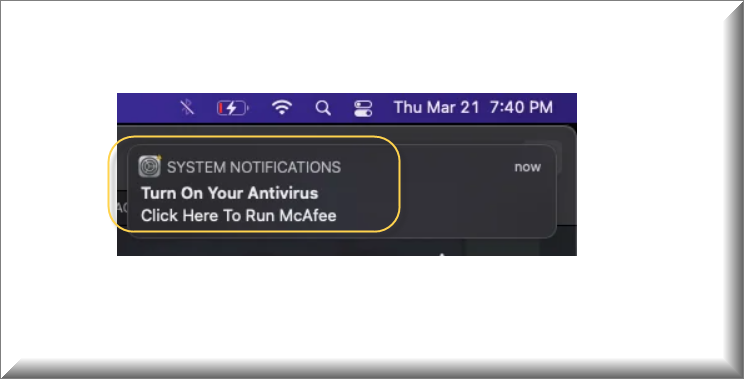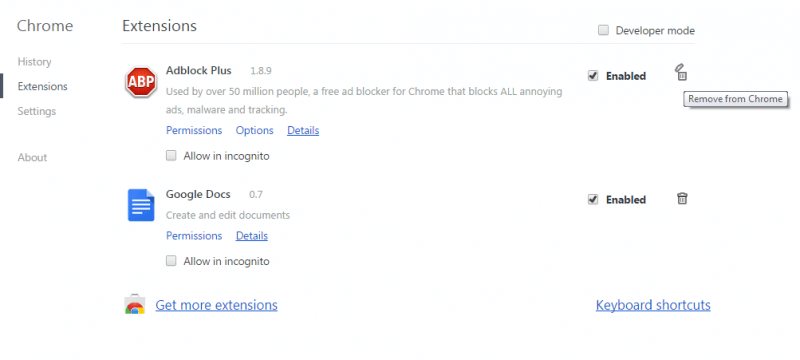In the digital age, where our lives intertwine with our devices, encountering pop-ups like “SYSTEM NOTIFICATIONS” on your Mac can be more than just a nuisance; it can signal a security concern. This comprehensive guide will shed light on the “SYSTEM NOTIFICATIONS” scam, how it affects Mac users, and effective strategies for prevention and removal. By understanding the nature of these pop-ups and taking proactive steps, you can safeguard your online presence.

What is “SYSTEM NOTIFICATIONS”?
“SYSTEM NOTIFICATIONS” refers to deceptive pop-up messages that appear on Mac computers, falsely claiming to be system alerts. These notifications may prompt you to download antivirus software or renew subscriptions, such as McAfee, under the guise of legitimate system warnings. However, they are, in fact, scam attempts designed to mislead users into downloading potentially malicious software or parting with personal information.

Key Characteristics:
- Misleading Labels: Pop-ups are disguised with system-like icons and language.
- Spammy Webpages: Clicking on these notifications redirects users to untrustworthy websites.
- Fake Urgency: Messages create a false sense of urgency, pressuring users to act immediately.
How to Avoid “SYSTEM NOTIFICATIONS” Scam
Protecting your Mac from such scams involves a mix of preventive measures and browser settings adjustments:
- Be Skeptical of Pop-ups: Always question the authenticity of abrupt notifications, especially those urging software downloads.
- Update Your Mac Regularly: Ensure your operating system and all applications are up-to-date, leveraging the latest security patches.
- Adjust Safari Settings: Limit notification permissions in Safari. Navigate to Safari’s preferences, select the Websites tab, then Notifications, and disallow permissions for unknown or suspicious sites.
Is “SYSTEM NOTIFICATIONS” Real?
No, “SYSTEM NOTIFICATIONS” messages are not legitimate system alerts from macOS. They are crafted by scammers to mimic the appearance of real notifications to trick users into engaging with them.

Removal of “SYSTEM NOTIFICATIONS” Pop-ups from Mac
If your Mac is already displaying these pop-ups, here’s how to eliminate them:
- Close Suspicious Apps: Quit any applications that you don’t recognize or that seem to be behaving unusually.
- Check Your Applications Folder: Look for any applications that you don’t remember installing. If you find anything suspicious, drag it to the Trash.
- Adjust Safari’s Settings: Follow the instructions mentioned earlier to prevent Safari from accepting notification permissions from untrustworthy sites. Specifically, go to Safari > Preferences > Websites > Notifications. Here, review the list and remove permissions for any site you don’t recognize or trust.
- Scan Your Mac for Malware: Consider using a reputable antivirus program to scan your Mac for any malware or adware that might have been installed. While macOS is generally resilient to viruses designed for Windows, it’s not immune to all threats.
How “SYSTEM NOTIFICATIONS” Infect Your Mac
The primary method through which these scams infect Macs is via deceptive advertising on the web or through bundled software installations. When users inadvertently grant permission for notifications from malicious websites or install dubious software, it paves the way for these pop-ups to appear.
Tips to Block and Remove All Scam Pop-ups
Ensuring your Mac remains free from such nuisances requires vigilance and regular maintenance:
- Use a Pop-up Blocker: Most web browsers offer built-in pop-up blockers or support extensions that can help prevent unwanted pop-ups.
- Regularly Clear Browser Cache and Cookies: This can prevent tracking and reduce the likelihood of being targeted by scam ads.
- Be Cautious with Software Downloads: Only download software from trusted sources and pay close attention during the installation process to avoid unintentionally installing additional programs.
Ensuring Safe Online Practices
After removing the immediate threat of “SYSTEM NOTIFICATIONS” it’s crucial to adopt habits that will keep your Mac safe:
- Back Up Your Data: Regular backups can save you from data loss in case of malware attacks.
- Educate Yourself: Awareness of common scams can help you recognize and avoid them.
- Use Comprehensive Security Software: Consider investing in comprehensive security solutions that offer real-time protection against malware and phishing attempts.
In conclusion, while “SYSTEM NOTIFICATIONS” and Zinskynots pop-ups on Mac are indeed concerning, understanding their nature and implementing the strategies outlined above can help you avoid falling victim to such scams. By adjusting browser settings, being cautious of suspicious downloads, and maintaining your Mac’s security through updates and antivirus software, you can significantly reduce the risk of encountering these and similar online threats. Remember, staying informed about the latest scams and exercising caution online are your best defenses against any form of cyber deception. Keep your digital life secure by adopting a proactive approach to online safety.
SUMMARY:
| Name | “SYSTEM NOTIFICATIONS” |
| Type | Adware/Browser Hijacker |
| Danger Level | Medium (nowhere near threats like Ransomware, but still a security risk) |
| Symptoms | Popups, banners, box messages and other online ads start filling your screen regardless of the pages you visit. |
| Distribution Method | As an added component to the installers of other applications, such as different system optimization tools, etc. |
| Detection Tool |
“SYSTEM NOTIFICATIONS” Removal
For a quick way to remove “SYSTEM NOTIFICATIONS” try to do this inside your Mac browser:
- Open your Mac browser.
- Go to Preferences.
- Now navigate to the extensions sub-menu.
- Look for any unfamiliar entries, including “SYSTEM NOTIFICATIONS”.
- Remove “SYSTEM NOTIFICATIONS” from your Mac as well as any other suspicious-looking items by clicking on the trash bin icon.
If this does not help then continue reading this article for more detailed instructions on how to get rid of “SYSTEM NOTIFICATIONS”!

The first thing you need to do is to Quit Safari (if it is opened). If you have trouble closing it normally, you may need to Force Quit Safari:
You can choose the Apple menu and click on Force Quit.
Alternatively, you can simultaneously press ⌘ (the Command key situated next to the space bar), Option (the key right next to it) and Escape (the key located at the upper left corner of your keyboard).
If you have done it right a dialog box titled Force Quit Applications will open up.
In this new dialog window select Safari, then press the Force Quit button, then confirm with Force Quit again.
Close the dialog box/window.

WARNING! READ CAREFULLY BEFORE PROCEEDING!
Start Activity Monitor by opening up Finder, then proceed to
Once there, look at all the processes: if you believe any of them are hijacking your results, or are part of the problem, highlight the process with your mouse, then click the “i” button at the top. This will open up the following box:

Now click on Sample at the bottom:

Do this for all processes you believe are part of the threat, and run any suspicious files in our online virus scanner, then delete the malicious files:


The next step is to safely launch Safari again. Press and hold the Shift key while relaunching Safari. This will prevent Safari’s previously opened pages from loading again. Once Safari is opened up, you can release the Shift key.
On the off chance that you are still having trouble with scripts interrupting the closing of unwanted pages in Safari, you may need to take some additional measures.
First, Force Quit Safari again.
Now if you are using a Wi-Fi connection turn it off by selecting Wi-Fi off in you Mac’s Menu. If you are using a cable internet (Ethernet connection), disconnect the Ethernet cable.

Re-Launch Safari but don’t forget to press and hold the Shift button while doing it, so no previous pages can be opened up. Now, Click on Preferences in the Safari menu,

and then again on the Extensions tab,

Select and Uninstall any extensions that you don’t recognize by clicking on the Uninstall button. If you are not sure and don’t want to take any risks you can safely uninstall all extensions, none are required for normal system operation.![]()
The threat has likely infected all of your browsers. The instructions below need to be applied for all browsers you are using.
Again select Preferences in the Safari Menu, but this time click on the Privacy tab,
Now click on Remove All Website Data, confirm with Remove Now. Keep in mind that after you do this all stored website data will be deleted. You will need to sign-in again for all websites that require any form of authentication.
Still in the Preferences menu, hit the General tab

Check if your Homepage is the one you have selected, if not change it to whatever you prefer.
Select the History menu this time, and click on Clear History. This way you will prevent accidentally opening a problematic web page again.
How to Remove “SYSTEM NOTIFICATIONS” From Firefox in OSX:
Open Firefox, click on ![]() (top right) ——-> Add-ons. Hit Extensions next.
(top right) ——-> Add-ons. Hit Extensions next.

The problem should be lurking somewhere around here – Remove it. Then Refresh Your Firefox Settings.
How to Remove “SYSTEM NOTIFICATIONS” From Chrome in OSX:
Start Chrome, click ![]() —–>More Tools —–> Extensions. There, find the malware and select
—–>More Tools —–> Extensions. There, find the malware and select ![]() .
.

Click ![]() again, and proceed to Settings —> Search, the fourth tab, select Manage Search Engines. Delete everything but the search engines you normally use. After that Reset Your Chrome Settings.
again, and proceed to Settings —> Search, the fourth tab, select Manage Search Engines. Delete everything but the search engines you normally use. After that Reset Your Chrome Settings.
If the guide doesn’t help, download the anti-virus program we recommended or try our free online virus scanner. Also, you can always ask us in the comments for help!

Leave a Comment